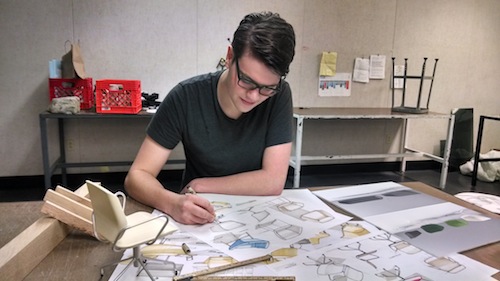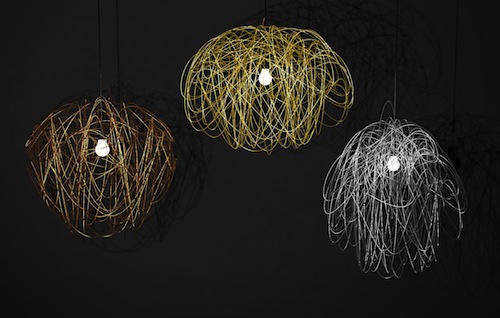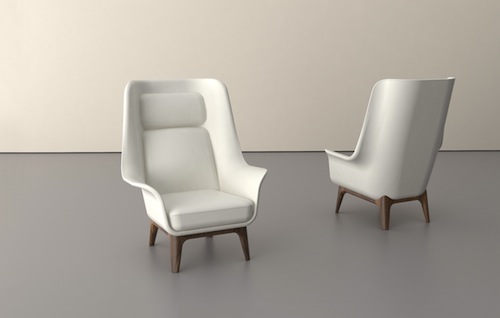
Hines Fischer drafts his “people-centric” designs
One of the first students to enroll in the Furniture and Fixtures track of Art Center’s Graduate Environmental Design program when it launched, Hines Fischer specializes in “people-centric” furniture design for office spaces. He is among a select group of students to represent the College at both the 2013 and 2014 International Contemporary Furniture Fair (ICFF) during New York Design Week.
Last year, he says, “it was really nice to get the chance to go to a show like this before I had jobs on the line, so that I could kind of take in the landscape. I took a lot of notes and met a lot of famous designers, which was an incredible experience.” Fischer also reconnected there with people he had met while interning at a furniture company prior to coming to Art Center. “I reminded them that I would be graduating soon.”
Before enrolling at Art Center, Fischer studied industrial design at Carnegie Mellon University and furniture design at the Royal Danish Academy of Fine Arts. He chose the Art Center graduate program because it is “very industry informed,” he says. “It’s very much about what companies want, and what people want from furniture designers.”
“I believe with full conviction that this is the best program for furniture design in the world right now. None of the other programs I looked at—and I looked at a lot—really addressed in the right way making a living as a furniture designer and making it work. Deciding to go to Art Center,” he says, “is the best decision I’ve made in my life.”
Art Center, he adds, addresses what is happening in furniture design right now and where young designers have opportunities to make their impact. But programs that focus primarily on the cutting edge of expression and avant-garde design don’t provide a realistic approach to starting a career, Fischer feels. Art Center strikes a balance. “You really need to start with the fundamentals before trying to change the world of design. But not in a way where it’s like, ‘oh, your designs have to be marketable’—cost projections and all that. It’s more like, ‘you have to think about the end-user and the company.’
“Once you start living and breathing furniture every day, you’re constantly thinking about manufacturing capabilities and all that,” Fischer says But if, for example, the job is to design a chair that needs to fit a certain price point and use specific materials, he says, “I immediately start thinking of ways that I can creatively do above and beyond what they expect. I think cleverness and the ability to take a few things and do a lot with them is one of my favorite attributes of design.”

Lighting fixtures designed by Hines Fischer
For his graduate thesis, Fischer explored the economic and social effect of new trends in office design and created a collection of furniture—“Soft Working”—that would define space in open-plan business settings with a comfortable, residential feel.
“More and more people are starting to question and think about how people are moving objects, and how they should move through the space of where they work,” he says. “If a family room is where a family comes together, where does an office come together? I started thinking about redesigning the meeting room. The largest stress in the space is this huge table that doesn’t really relate to how people collaborate and innovate in their spaces.”
Fischer’s solution: informal seating and work surfaces that include pillows that function as both seating and desks. Fischer’s recent original work includes the lightweight, seabird-inspired task chair Brisa; an airy stacking café chair called Ebb; an inviting high-backed chair named Nestle; Hug, a friendly home workstation; and Twig, a delicate, nature-inspired standing lamp. Each design is rooted in Fischer’s belief that furniture should evoke an emotional response.
“It’s not enough for furniture to be just furniture anymore,” he says. Art Center stresses the importance of thinking about “why your piece of furniture should exist,” Fischer notes. “It’s not enough that it’s just a new way of doing a joint or a design. It has become important in the industry that each piece of furniture is wrapped up in a story and an idea beyond its physical form.”
On a superficial level, Fischer says, “it’s to sell it, but on an emotional level, it’s very important to me that every piece that I’ve designed just makes people smile. I think it’s important to make products that people love.”
Lynne Heffley is a Los Angeles-based freelance journalist who writes about the arts.










